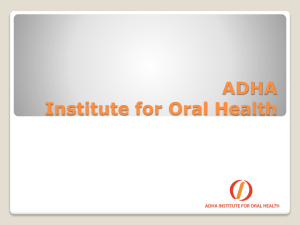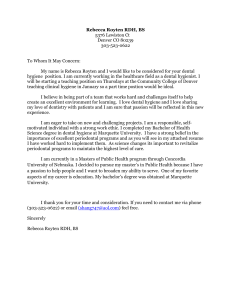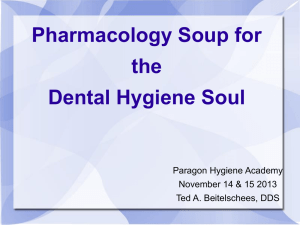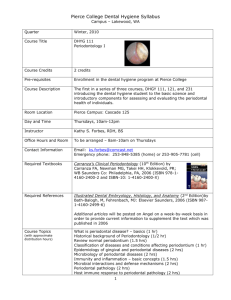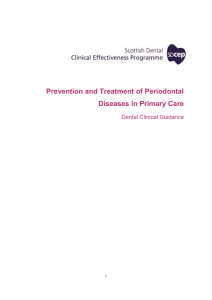DHY 213 - E
advertisement
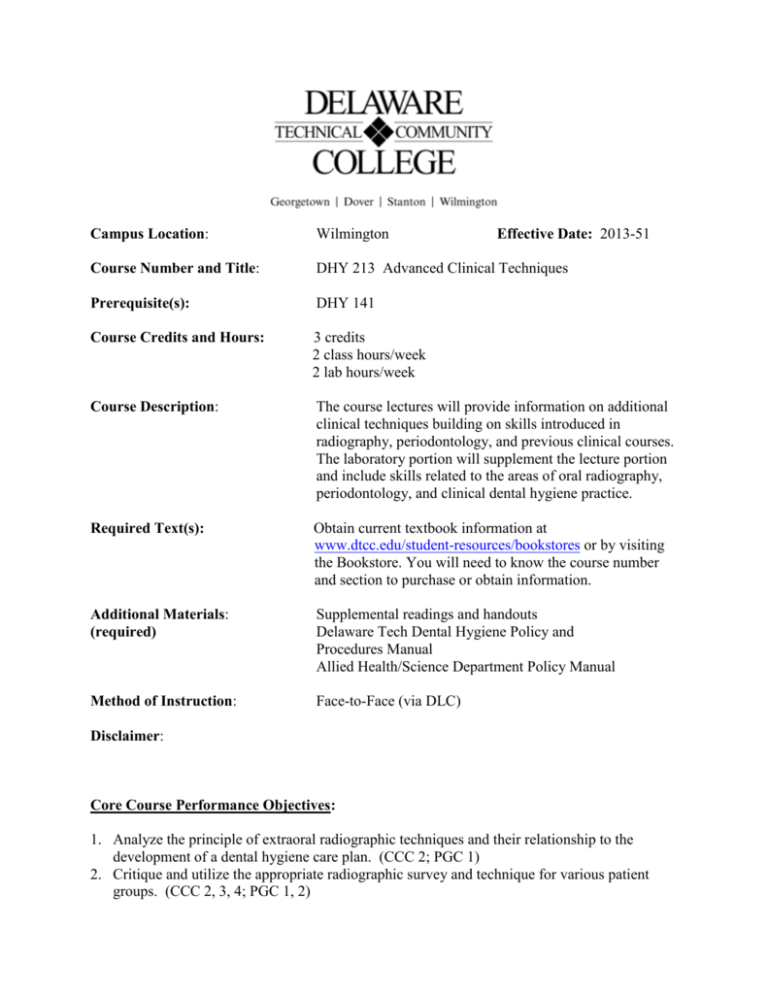
Campus Location: Wilmington Effective Date: 2013-51 Course Number and Title: DHY 213 Advanced Clinical Techniques Prerequisite(s): DHY 141 Course Credits and Hours: 3 credits 2 class hours/week 2 lab hours/week Course Description: The course lectures will provide information on additional clinical techniques building on skills introduced in radiography, periodontology, and previous clinical courses. The laboratory portion will supplement the lecture portion and include skills related to the areas of oral radiography, periodontology, and clinical dental hygiene practice. Required Text(s): Obtain current textbook information at www.dtcc.edu/student-resources/bookstores or by visiting the Bookstore. You will need to know the course number and section to purchase or obtain information. Additional Materials: (required) Supplemental readings and handouts Delaware Tech Dental Hygiene Policy and Procedures Manual Allied Health/Science Department Policy Manual Method of Instruction: Face-to-Face (via DLC) Disclaimer: Core Course Performance Objectives: 1. Analyze the principle of extraoral radiographic techniques and their relationship to the development of a dental hygiene care plan. (CCC 2; PGC 1) 2. Critique and utilize the appropriate radiographic survey and technique for various patient groups. (CCC 2, 3, 4; PGC 1, 2) 3. Demonstrate the correct clinical technique for amalgam maintenance, air-abrasive polishing, advanced instrumentation, intra-oral photography, and occlusal evaluation. (CCC 2, 3; PGC 1, 2, 3) 4. Critique the rationale for various therapies utilized in periodontal treatment. (CCC 1, 2; PGC 1) See Core Curriculum Competencies (CCC) and Program Graduate Competencies (PGC) at the end of the syllabus. Course objectives are coded to the competency(cies) they develop. Measurable Performance Objectives: The student will be able to: 1. Analyze the principles of extra oral radiographic techniques and their relationship to the development of a dental hygiene plan. 1.1 Recognize extra oral radiographs, which are most commonly used in dentistry and list their purpose for patient care. 1.2 Explain the principles of panographic technique and simulate taking a panograph on the clinical extra oral machine. 1.3 Discuss the advantages and limitations of the panographic survey. 2. Critique and utilize the appropriate radiographic survey and technique for various patient groups. 2.1 Evaluate and identify technique and positioning errors in panoramic radiographs, and discuss how to correct the errors. 2.2 Explain the principles of, as well as the advantages and limitations of the bisecting-theangle technique. 2.3 Correctly utilize the bisecting technique in exposing films utilizing various film holding devices. 2.4 Compare and contrast the paralleling and bisecting technique in theory, principles, and image quality. 2.5 Correctly employ digital radiography on Dexter. 2.6 Employ the recommended methods for radiation thrift and hygiene for the patient and operator at all times when exposing dental radiographs. 2.7 Evaluate his/her own radiographic products for diagnostic value, and identify any exposure or processing errors. 2.8 Differentiate between normal and abnormal conditions of the teeth and supporting structures in oral radiographs. 2.9 Explain the principles employed in the “Buccal-Object Rule” localization technique, and employ this technique on Dexter. 3. Demonstrate the correct clinical technique and patient selection for amalgam maintenance, air-abrasive polishing, advanced instrumentation, intra-oral photography, and occlusal evaluation. 3.1 List uses of intraoral photography. 3.2 Demonstrate the use of an intraoral camera to expose the various intraoral photographic views and properly maintain the equipment. 3.3 Demonstrate the correct technique for finishing and polishing an amalgam so that the tooth structure and amalgam are flush at the cavosurface margins and polished to a smooth, shiny surface. 3.4 Recognize common restorative materials. 3.5 Recognize caries and common deficiencies of restorations. 3.6 Identify the indications, contraindications, advantages and disadvantages of air-powder polishing. 3.7 Demonstrate the proper use of an air-powder polishing. Demonstrate the proper use of the Piezo ultrasonic scaling and the right/left curved ultrasonic tips. 3.9 Discuss the instrument design, indications, and limitations of chisels, hoes, and periodontal files. 3.9 Discuss situations in which a special variation to the norm in instrumentation is needed for effective tooth deposit removal utilizing ultrasonic instrumentation. 4. Critique the rationale for various therapies utilized in periodontal treatment 4.1 Discuss the various methods of pain control used in dentistry. 4.2 Discuss the special considerations pertaining to maintenance therapy of patients with dental implants. 4.3 Discuss the role of laser therapy in dentistry and dental hygiene. 4.4 Compare and contrast the various surgical procedures employed in periodontal therapy. 4.5 State the purposes of suture placement and periodontal dressing application following periodontal surgery. 4.6 Describe the procedure for removing sutures, including referral to and completion of patient record. 4.7 Describe and demonstrate the procedures for placing and removing a periodontal dressing. 4.8 Discuss the rationale for performing an occlusal assessment and interpret the need for referral to the appropriate specialist. Evaluation Criteria/Policies: Students will demonstrate proficiency on all Core Course Performance Objectives at least to the 75 percent level to successfully complete the course. The grade will be determined using the College Grading System: 92 – 100 = A 83 – 91 = B 75 – 82 = C 0 – 74 = F Students should refer to the Student Handbook for information on Academic Standing Policy, Academic Honesty Policy, Student Rights and Responsibilities, and other policies relevant to their academic progress. Core Curriculum Competencies: (The competencies every graduate will develop) 1. 2. 3. 4. 5. 6. 7. Communicate clearly and effectively both orally and in writing. Demonstrate effective problem solving and reasoning skills. Work effectively in groups of people from diverse backgrounds. Demonstrate ethical and professional understanding and conduct. Apply appropriate information literacy skills to locate, evaluate, and use information effectively. Use computer technology appropriate to the field. Use scientific and mathematical reasoning appropriate to the technology. Program Graduate Competencies: (The competencies every graduate will develop specific to his/her major) 1. 2. 3. 4. 5. 6. Collect and analyze baseline data in a critical and scientific manner regarding the patient's health status to determine dental hygiene treatment needs. Utilizing professional communication skills and behaviors, initiate and responsibly advocate health care promotion and disease prevention for diverse populations. Provide dental hygiene care in a safe manner. Utilizing self-assessment skills, evaluate clinical performance and the effectiveness of dental hygiene treatment. Accurately document information related to dental hygiene care through proper record keeping. Recognize and manage the professional and ethical issues of dental hygiene practice in a dynamic environment.


